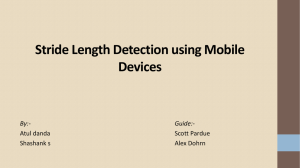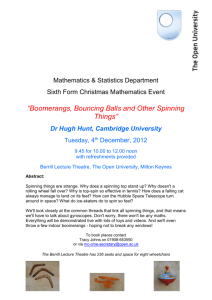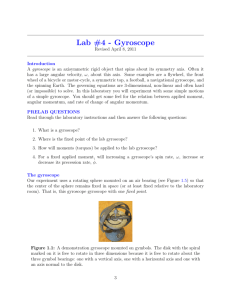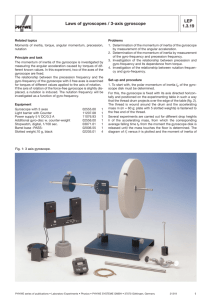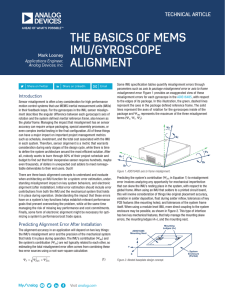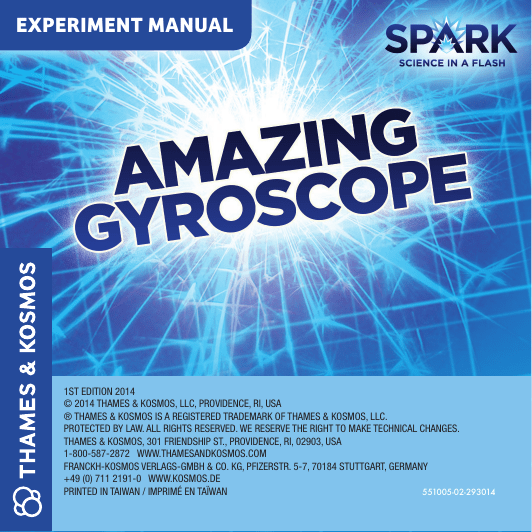
EXPERIMENT MANUAL
1ST EDITION 2014
© 2014 THAMES & KOSMOS, LLC, PROVIDENCE, RI, USA
® THAMES & KOSMOS IS A REGISTERED TRADEMARK OF THAMES & KOSMOS, LLC.
PROTECTED BY LAW. ALL RIGHTS RESERVED. WE RESERVE THE RIGHT TO MAKE TECHNICAL CHANGES.
THAMES & KOSMOS, 301 FRIENDSHIP ST., PROVIDENCE, RI, 02903, USA
1-800-587-2872 WWW.THAMESANDKOSMOS.COM
FRANCKH-KOSMOS VERLAGS-GMBH & CO. KG, PFIZERSTR. 5-7, 70184 STUTTGART, GERMANY
+49 (0) 711 2191-0 WWW.KOSMOS.DE
PRINTED IN TAIWAN / IMPRIMÉ EN TAÏWAN
551005-02-293014
SAFETY
WARNING!
Not suitable for children under 3 years. Choking hazard —
small parts may be swallowed or inhaled. Strangulation
hazard — long cords may become wrapped around the
neck.
Keep the packaging and instructions, as they contain
important information.
THE AMAZING GYROSCOPE!
From smartphones, tablets, and video game controllers to
airplanes and telescopes, gyroscopes are found in many
places. With this kit, you can explore the astonishing
powers of the gyroscope and learn some of the physics
principles behind its behavior. The word “gyroscope”
comes from the Greek words gyro, for “circle” or
“rotation,” and skopeein, meaning “to see.” The name was
originally coined by a scientist who built the device in an
experiment to see Earth’s rotation.
EXPERIMENT 1: SPINNING TOP
1. Try to get the top to
balance on its tip with
no other part of it
touching the tabletop
and without spinning
the top. Can you do it?
2. Now try spinning the top
by flicking the handle
quickly with your fingers.
Can you get the top to
balance on its tip?
3. Try putting the three
different pattern cards
onto the top to help you
observe how the top is
spinning.
EXPERIMENT 2: CENTER OF GRAVITY
1. Tape a dime to the
underside of each
upper butterfly wing.
Now you can balance
the butterfly at its
head.
2. Because of the
coins you taped on,
the center of the
butterfly’s gravity
is right at the head,
rather than in the
center. An object can
be balanced if it is
supported by its center
of gravity. That’s how
you can balance it on
your finger with your
finger at its head.
EXPERIMENT 3: GYROSCOPE
1. Thread the string through the
small hole in the gyroscope’s
axis. Roll up the string around
the axis.
2. Hold the gyroscope frame
tightly and pull hard on
the string to get the rotor
wheel spinning.
3. For the first spin, hold the
gyroscope and feel the
forces.
4. Spin it a second time and
put it down on the table.
How long can you get it
to stay spinning?
5. Tie a piece of yarn or cord
between two fixed points,
such as two table legs.
6. Spin the gyroscope
with its string. Balance
the gyroscope on the
tightrope by placing
its notched tip on the
tightrope.
7. Spin the gyroscope again.
Are you able to balance it
on your fingertip?
THE PHYSICS OF THE GYROSCOPE
Gravity is a force of attraction between objects. The more
massive an object, the stronger its gravity. Earth’s gravity
acts so strongly on us because it is so large compared to
us. Earth’s gravity pulls all objects near Earth toward its
center of gravity.
The spinning top in Experiment 1 stayed balanced because
of the gyroscopic principle, which says that a spinning
object tends to stay in its plane of
rotation unless an external force acts
on it. The gyroscopic effect counters
the force of gravity and keeps the top
from falling over. Friction between
the top and the tabletop as well
as between the top and the
air eventually cause the top
to slow down and fall over.
That’s why a top can’t stay
spinning forever! How long
can you get your top to spin?
A top spins so fast that as soon as its weight becomes
unbalanced and it starts to fall to one side, the imbalance
has spun around to the other side. As long as it is spinning
fast enough, it’s like the top is falling to all sides evenly
and therefore staying balanced.
A gyroscope is like a spinning top held inside a frame by
its axis. They were invented as tools to help scientists
study Earth’s rotation. Today gyroscopes are used in many
applications such as compasses, flight instruments, and
stabilization devices.
Precession
The gyroscopic effect
keeps the gyroscope
upright. However, it
will respond to external
forces with a change in
the direction of its axis
of rotation. This change
in movement is called
precession.
Axis of
rotation

